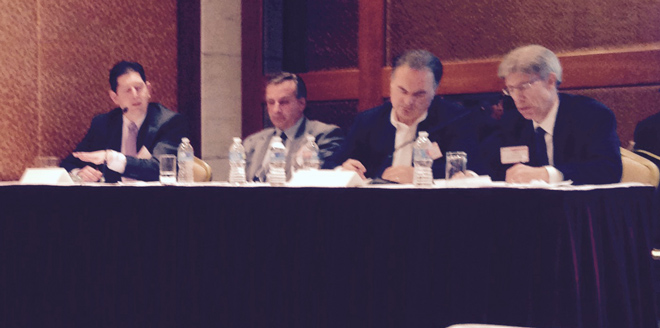By William Opalka
NEW YORK — Distributed resources are receiving too much blame for the utility industry’s problems, current and former regulators said at the Infocast Grid Transformation Summit 2015 last week.
“I think the main problem is the declining sales of energy,” said Betty Ann Kane, chairman of the D.C. Public Service Commission. Kane said distribution-only utilities facing declining revenue due to their dependence on volumetric rates will find it difficult to modernize the system for rooftop solar and other distributed resources.
“We have started to move gradually — and I would say too gradually — away from the volumetric charges to have a customer charge pick up more of the costs,” she said.
In D.C., the monthly service charge for meter reading and grid connection has gone from $6 to $12 since 2007 and is headed toward $20, Kane said.
Other speakers at the conference, which drew about 100 people to the ONE UN New York hotel, spoke of renewable energy’s progress — and the backlash against it.
“There have been efforts in a number of states to pull back on [renewable portfolio standards],” said former Federal Energy Regulatory Commission chairman Jon Wellinghoff, now a partner in the law firm Stoel Rives. “On the other hand, there have been efforts to increase renewables. One of the most notable is California, which recently set its goal to 50%.”
Wellinghoff noted that renewables’ declining costs mean the mandates are less necessary than before.
“At the wholesale level we’re seeing wind at less than 3 cents/kWh and the average at utility-scale solar generation is less than 7 cents/kWh. That’s an average for all the contracts signed in 2014, while some are at 5 cents,” he said.
Fixed Costs vs. System Benefits
Wellinghoff also disputed claims that net metering and renewable subsidies result in low-income customers subsidizing wealthier customers able to afford rooftop solar. Wellinghoff cited studies showing that distributed resources provide net benefits to the grid.
“The problem is they’re not analyzing the entire benefits to the system with these distributed systems,” Wellinghoff said of critics. “You can’t look solely at the costs of energy, of retail rates versus wholesale costs. It’s avoiding new generation, it’s avoiding new transmission.”
“I think the concern about the cross-subsidization is solar is overplayed,” Kane agreed.
NREL Study
The National Renewable Energy Laboratory in Golden, Colo., is studying the operational challenges facing utilities on a 1-MW system with distributed solar, smart devices, electric vehicles and other technologies.
Bryan Hannegan, associate director of energy systems integration for the lab, described the questions NREL is attempting to answer: “When you have a more distributed and dynamic grid, how do you operate that in a way that doesn’t sacrifice reliability and affordability that consumers have come to expect, while pursuing the clean energy objectives we’ve set out for ourselves as a nation?”


